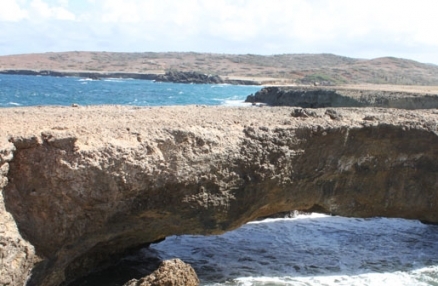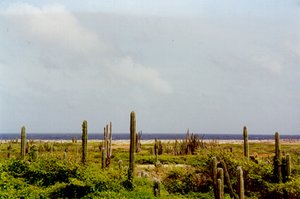Ecoregions of Aruba
Ecoregions of Countries Collection 
There are two chief elements that comprise the ecoregions of Aruba: the Aruba-Curaçao-Bonaire cactus scrub and the Amazon-Orinoco Caribbean mangroves. Although Caribbean islands are often depicted as lush tropical paradises, Aruba shares the desert scrub known as the [[Aruba-Curaçao-Bonaire cactus scrub] ecoregion] with the islands of Curaçao and Bonaire (sometimes collectively termed the A-B-C’s). This dry desert scrub ecoregion receives little rainfall. A haven for avifauna, over two hundred bird species are found here, many of which are endangered. Tourism is a major threat to this habitat as development for. Also, feral goats and sheep destroy much of the natural vegetation through overgrazing. Columnar cacti are common, and can grow up to six meters (Cactus) tall. The dominant cacti species are: Stenocereus griseus, Subpilocereus repandus, and Pilosocereus lanuginosus. These species flower and fruit profusely during the dry season, and provide critical resources for a variety of bats, birds and other fauna.
There are very few endemic plant species on the islands: only two on Aruba. Nevertheless, the floral community has a distinct character. The xerophytic community of the ABC’s may not have the diversity of a tropical rainforest, but it does boast a unique fauna, with its own radiation’s. The most important components of this community are the cacti- they dominate the landscape and provide critical food resources for nectarivores and frugivores.
Contents
Aruba-Curacao-Bonaire cactus scrub
Lizards are an abundant and diverse component of the cactus scrub community on Aruba. Iguanas are especially abundant, despite the fact that they are often hunted and used in soups and stews. There are endemic lizards on all three islands, as well as species with more widespread distributions. Aruba also has two snakes: the cascabel (Crotalus thurissus unicolor), an endangered subspecies of rattlesnake, which does not use its rattle; and the Aruba cat-eyed snake (Leptodira bakeri). There are approximately 200 resident bird species on the three islands, many of which are rare. Species of particular concern include the endangered Bonaire Lora (Amazonia barbadensis) and Aruban burrowing owl (Athene cunicularia arubensis), the Aruban parakeet (Aratinga pertinax arubensis), Bonaire Green parrot, and flamingos. The flamingo breeding grounds on Bonaire are protected by a special sanctuary. The islands are also a favored stop-over and wintering ground for North American avian migrants.
Amazon Orinoco Caribbean mangroves
Portions of the coastline are given to these mangrove habitats. They support an array of animal and plant species that are unique to these mangrove communities of the southern Caribbean Basin. There is a considerable diversity of coastal formations in the same area: estuaries, mangroves, coastal dunes, lagoons and marshes; however in many parts of Aruba the cactus scrub runs directly to the coastline, with no mangrove formations. Mangroves synthesize organic matter, and promote nutrient filtering making them crucial for the maintenance of high productivity in southern Caribbean coastal zones.
Context
Ecoregions are areas that:
[1] Share a large majority of their species and ecological dynamics;
[2] Share similar environmental conditions; and,
[3] Interact ecologically in ways that are critical for their long-term persistence.
Scientists at the World Wildlife Fund, have established a classification system that divides the world in 867 terrestrial ecoregions, 426 freshwater ecoregions and 229 marine ecoregions that reflect the distribution of a broad range of fauna and flora across the entire planet.
References
- Caribbean Conservation Association. 1980. Survey of conservation priorities in the Lesser Antilles: Bonaire, Preliminary Data Atlas. Eastern Caribbean Natural Area Management Program, Caribbean Conservation Association, the University of Michigan and the United Nations.
- Caribbean Conservation Association. 1980. Survey of conservation priorities in the Lesser Antilles: Curaçao, Preliminary Data Atlas. Eastern Caribbean Natural Area Management Program, Caribbean Conservation Association, the University of Michigan and the United Nations.
- Caribbean Conservation Association. 1980. Survey of conservation priorities in the Lesser Antilles: Aruba, Preliminary Data Atlas. Eastern Caribbean Natural Area Management Program, Caribbean Conservation Association, the University of Michigan and the United Nations.
- Debrot, A. O. and J. A. deFreitas. 1993. A comparison of ungrazed and livestock-grazed rock vegetations in Curaçao. Biotropica 25(3): 270-280.
- Debrot, A. O. et al. 1999. The butterfly fauna of Curaçao, West Indies: 1996 status and long-term species turnover. Caribbean Journal of Science 35: 184-194.
- Petit, S. 1996. The status of bats on Curaçao. Biological Conservation 77(1): 27-31.
- Petit, S. and L. Pors. 1996. Survey of columnar cacti and carrying capacity for nectar-feeding bats on Curaçao. Conservation Biology 10(3): 769-775.
- Stoffers, A.L. 1956. Studies on the flora of Curaçao and other Caribbean islands. Vol. 1: The vegetation of the Netherlands Antilles. Utrecht
- World Wildlife Fund. 1994. Ecoregional Workshop: A Conservation Assessment of Mangrove Ecoregions of Latin America and the Caribbean.

